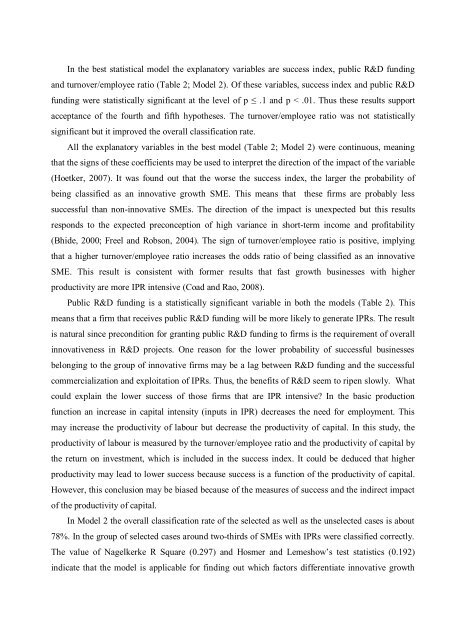dissertation in pdf-format - Aalto-yliopisto
dissertation in pdf-format - Aalto-yliopisto
dissertation in pdf-format - Aalto-yliopisto
You also want an ePaper? Increase the reach of your titles
YUMPU automatically turns print PDFs into web optimized ePapers that Google loves.
In the best statistical model the explanatory variables are success <strong>in</strong>dex, public R&D fund<strong>in</strong>g<br />
and turnover/employee ratio (Table 2; Model 2). Of these variables, success <strong>in</strong>dex and public R&D<br />
fund<strong>in</strong>g were statistically significant at the level of p .1 and p < .01. Thus these results support<br />
acceptance of the fourth and fifth hypotheses. The turnover/employee ratio was not statistically<br />
significant but it improved the overall classification rate.<br />
All the explanatory variables <strong>in</strong> the best model (Table 2; Model 2) were cont<strong>in</strong>uous, mean<strong>in</strong>g<br />
that the signs of these coefficients may be used to <strong>in</strong>terpret the direction of the impact of the variable<br />
(Hoetker, 2007). It was found out that the worse the success <strong>in</strong>dex, the larger the probability of<br />
be<strong>in</strong>g classified as an <strong>in</strong>novative growth SME. This means that these firms are probably less<br />
successful than non-<strong>in</strong>novative SMEs. The direction of the impact is unexpected but this results<br />
responds to the expected preconception of high variance <strong>in</strong> short-term <strong>in</strong>come and profitability<br />
(Bhide, 2000; Freel and Robson, 2004). The sign of turnover/employee ratio is positive, imply<strong>in</strong>g<br />
that a higher turnover/employee ratio <strong>in</strong>creases the odds ratio of be<strong>in</strong>g classified as an <strong>in</strong>novative<br />
SME. This result is consistent with former results that fast growth bus<strong>in</strong>esses with higher<br />
productivity are more IPR <strong>in</strong>tensive (Coad and Rao, 2008).<br />
Public R&D fund<strong>in</strong>g is a statistically significant variable <strong>in</strong> both the models (Table 2). This<br />
means that a firm that receives public R&D fund<strong>in</strong>g will be more likely to generate IPRs. The result<br />
is natural s<strong>in</strong>ce precondition for grant<strong>in</strong>g public R&D fund<strong>in</strong>g to firms is the requirement of overall<br />
<strong>in</strong>novativeness <strong>in</strong> R&D projects. One reason for the lower probability of successful bus<strong>in</strong>esses<br />
belong<strong>in</strong>g to the group of <strong>in</strong>novative firms may be a lag between R&D fund<strong>in</strong>g and the successful<br />
commercialization and exploitation of IPRs. Thus, the benefits of R&D seem to ripen slowly. What<br />
could expla<strong>in</strong> the lower success of those firms that are IPR <strong>in</strong>tensive? In the basic production<br />
function an <strong>in</strong>crease <strong>in</strong> capital <strong>in</strong>tensity (<strong>in</strong>puts <strong>in</strong> IPR) decreases the need for employment. This<br />
may <strong>in</strong>crease the productivity of labour but decrease the productivity of capital. In this study, the<br />
productivity of labour is measured by the turnover/employee ratio and the productivity of capital by<br />
the return on <strong>in</strong>vestment, which is <strong>in</strong>cluded <strong>in</strong> the success <strong>in</strong>dex. It could be deduced that higher<br />
productivity may lead to lower success because success is a function of the productivity of capital.<br />
However, this conclusion may be biased because of the measures of success and the <strong>in</strong>direct impact<br />
of the productivity of capital.<br />
In Model 2 the overall classification rate of the selected as well as the unselected cases is about<br />
78%. In the group of selected cases around two-thirds of SMEs with IPRs were classified correctly.<br />
The value of Nagelkerke R Square (0.297) and Hosmer and Lemeshow’s test statistics (0.192)<br />
<strong>in</strong>dicate that the model is applicable for f<strong>in</strong>d<strong>in</strong>g out which factors differentiate <strong>in</strong>novative growth
















